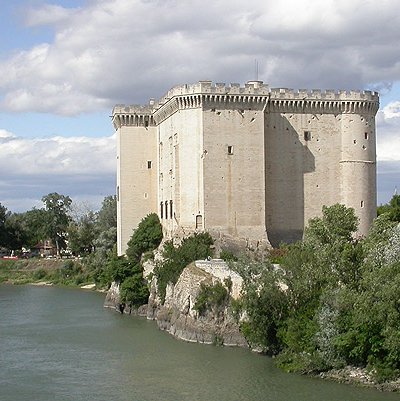
Like us on Facebook
PLACE NAMES


 
|
|
Tarascon
|

|
|
Tarascon is located 23 km (14 mi) south of Avignon and 20 km (12 mi) north of Arles, on the left (east) bank of the Rhône River. On the other side is the similarly sized town of Beaucaire in the departement of Gard, region of Languedoc-Roussillon. Directly opposite each other and connected by several bridges, Beaucaire and Tarascon effectively constitute one town, with about 30,000 inhabitants. An irrigation canal of 18,00 km length rejoins the Rhone near Tarascon.
The climate in the Alpilles is considered Mediterranean. The winters are mild and dry and the summers hot and dry. The maximum temperature is observed in July and August, the minimum temperature in December and January. The most rainy month is January with seven days of rain on average, against two days in July, the driest month. The Alpilles region receives more rainfall than the coast of the Mediterranean: 500 mm / year in the Camargue against 600-700 mm / year for the Alpilles. The mistral blows violently from the north or northwest, especially in winter and spring . The mistral blows strongly 100 days a year on average and more weakly for 83 days, which leaves only 182 windless days per year. Two types are distinguished ; the "white mistral", which clears the sky, and the rarer "black mistral", which is accompanied with rain.
Église collégiale Ste Marthe (St Martha's Collegiate Church) is where, according to a local tradition, the biblical figure Martha is buried. The church was built half-Romanesque in the 12th century and half-Gothic in the 14th century. The crypt dates from the 3rd century.
Collegiate Sainte-Marthe was dedicated in 1197 and enlarged in the 14th and 15th centuries. The crypt houses the relics of Martha in a sarcophagus of the fourth century.
The construction of the current castle of Tarascon was started in 1401 by Louis II of Anjou, after the previous castle was destroyed. The construction was continued by his first son, Louis III of Anjou, and was completed in 1449 by his second son, René I of Naples. Thus, the castle is often referred to as le château du roi René (King René's castle).
It was turned into a military prison in the 17th century, until its acquisition by the state in 1932.
It stands right on the banks of the Rhône opposite Château de Beaucaire, and near the Collegiate Church of St Martha.
The present castle replaced a fortress, built on the site of the Roman town to monitor the border of Provence. After the destruction perpetrated in 1399 by the bands of Raymond de Turenne, the Anjou family decided to rebuild it entirely. Between 1447 and 1449, René d'Anjou, who was the favorite residence, did refine the interior. Its massive silhouette posed beside the Rhône, the unexpected elegance of its interior architecture and its exceptional state of preservation make this one of the finest medieval castles of France. It consists of two independent parts: the South, the stately home, flanked by round towers on the city side and river side with walls of up to 48 m high and square towers and the North, the lower court that defends the rectangular constructions.
Other highlights
- Historical town centre, including the rue des Halles and its arcades
- Hôtel de Ville (Town Hall), built in 1648 in Baroque style. The statue of St. Martha slaying the Tarasque was conducted by the sculptor Louis Le Male.
- Cloître des Cordeliers, 16th-century cloister.
- Three city gates remain from the former city wall: Portail St. Jean, Porte de la Condamine and Porte Jarnègues.
- Church of Saint-Jacques, built between 1740 and 1745 by architect Antoine de Tarascon Damour, following the plans of the architect from Avignon Jean-Baptiste Franque.
- Frigolet Abbey
- The Chapel of St. Gabriel is a Roman-style church located southeast of Tarascon.
 Feel free to Email me any additions or corrections Feel free to Email me any additions or corrections
LINKS AVAILABLE TO YOUR SITE
| | |





